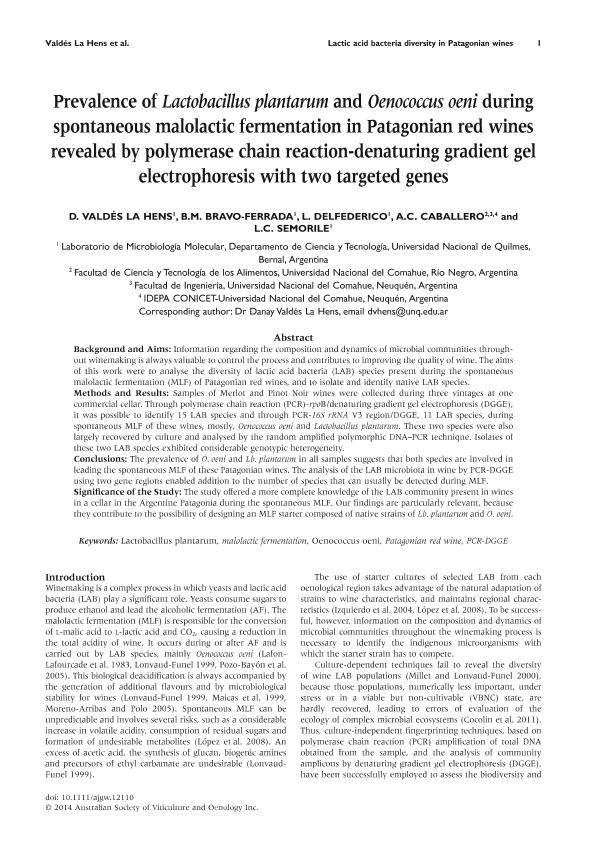Artículo
Prevalence of Lactobacillus plantarum and Oenococcus oeni during spontaneous malolactic fermentation in Patagonian red wines revealed by polymerase chain reaction-denaturing gradient gel electrophoresis with two targeted genes
Valdes la Hens, Danay ; Bravo Ferrada, Barbara Mercedes
; Bravo Ferrada, Barbara Mercedes ; Delfederico, Lucrecia
; Delfederico, Lucrecia ; Caballero, Adriana Catalina; Semorile, Liliana Carmen
; Caballero, Adriana Catalina; Semorile, Liliana Carmen
 ; Bravo Ferrada, Barbara Mercedes
; Bravo Ferrada, Barbara Mercedes ; Delfederico, Lucrecia
; Delfederico, Lucrecia ; Caballero, Adriana Catalina; Semorile, Liliana Carmen
; Caballero, Adriana Catalina; Semorile, Liliana Carmen
Fecha de publicación:
10/2014
Editorial:
Wiley Blackwell Publishing, Inc
Revista:
Australian Journal Of Grape And Wine Research
ISSN:
1322-7130
Idioma:
Inglés
Tipo de recurso:
Artículo publicado
Clasificación temática:
Resumen
Background and Aims:Information regarding the composition and dynamics of microbial communities through-out winemaking is always valuable to control the process and contributes to improving the quality of wine. The aimsof this work were to analyse the diversity of lactic acid bacteria (LAB) species present during the spontaneousmalolactic fermentation (MLF) of Patagonian red wines, and to isolate and identify native LAB species.Methods and Results:Samples of Merlot and Pinot Noir wines were collected during three vintages at onecommercial cellar. Through polymerase chain reaction (PCR)-rpoB/denaturing gradient gel electrophoresis (DGGE),it was possible to identify 15 LAB species and through PCR-16S rRNAV3 region/DGGE, 11 LAB species, duringspontaneous MLF of these wines, mostly,Oenococcus oeniandLactobacillus plantarum. These two species were alsolargely recovered by culture and analysed by the random amplified polymorphic DNA–PCR technique. Isolates ofthese two LAB species exhibited considerable genotypic heterogeneity.Conclusions:The prevalence ofO. oeniandLb. plantarumin all samples suggests that both species are involved inleading the spontaneous MLF of these Patagonian wines. The analysis of the LAB microbiota in wine by PCR-DGGEusing two gene regions enabled addition to the number of species that can usually be detected during MLF.Significance of the Study:The study offered a more complete knowledge of the LAB community present in winesin a cellar in the Argentine Patagonia during the spontaneous MLF. Our findings are particularly relevant, becausethey contribute to the possibility of designing an MLF starter composed of native strains ofLb. plantarumandO. oeni
Archivos asociados
Licencia
Identificadores
Colecciones
Articulos(SEDE CENTRAL)
Articulos de SEDE CENTRAL
Articulos de SEDE CENTRAL
Citación
Valdes la Hens, Danay; Bravo Ferrada, Barbara Mercedes; Delfederico, Lucrecia; Caballero, Adriana Catalina; Semorile, Liliana Carmen; Prevalence of Lactobacillus plantarum and Oenococcus oeni during spontaneous malolactic fermentation in Patagonian red wines revealed by polymerase chain reaction-denaturing gradient gel electrophoresis with two targeted genes; Wiley Blackwell Publishing, Inc; Australian Journal Of Grape And Wine Research; 21; 1; 10-2014; 49-56
Compartir
Altmétricas



